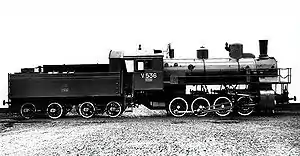| Ѵ (Izhitsa) class steam locomotive | |||||||||||||||||||||||||||||||||||||||
|---|---|---|---|---|---|---|---|---|---|---|---|---|---|---|---|---|---|---|---|---|---|---|---|---|---|---|---|---|---|---|---|---|---|---|---|---|---|---|---|
 | |||||||||||||||||||||||||||||||||||||||
| |||||||||||||||||||||||||||||||||||||||
| |||||||||||||||||||||||||||||||||||||||
| |||||||||||||||||||||||||||||||||||||||
| |||||||||||||||||||||||||||||||||||||||
The Russian steam locomotive class Izhitsa (Ѵ) was a steam locomotive produced in Russia and the Soviet Union between 1908 and 1918, and between 1927 and 1931. The Russian letter Ѵ can be transliterated as Hy. On Russian and Soviet railways, these were the most powerful steam locomotives of type 0-8-0. They were designed by E. E. Noltein and had a 16-ton axle load.[1]
Similar class
The Russian locomotive class Y (Ы) was similar but had a 15-ton axle load. In the period 1909–1916, 350 class Y (Ы) locomotives were built.
See also
- The Museum of the Moscow Railway, at Paveletsky Rail Terminal, Moscow
- Rizhsky Rail Terminal, Home of the Moscow Railway Museum
- Varshavsky Rail Terminal, St.Petersburg, Home of the Central Museum of Railway Transport, Russian Federation
- Finland Station, St.Petersburg
- History of rail transport in Russia
References
- ↑ Le Fleming, H.M.; Price, J.H. (1960). Russian Steam Locomotives. London: John Marshbank Ltd. p. 31.
- Локомотивы отечественных железных дорог 1845-1955. В.А. Раков Паровозы серии Ѵ (2nd ed.). Moscow: Транспорт. 1995. pp. 176–179. ISBN 5-277-00821-7.
- Локомотивы отечественных железных дорог 1845-1955. В.А. Раков Паровозы с четырьмя движущими колёсными парами (2nd ed.). Moscow: Транспорт. 1995. pp. 520–521. ISBN 5-277-00821-7.
External links
- The Moscow Railway Museum at Rizhsky Rail Terminal
- Report on a visit to the Varshavsky Rail Terminal
This article is issued from Wikipedia. The text is licensed under Creative Commons - Attribution - Sharealike. Additional terms may apply for the media files.